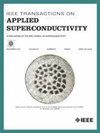Heterogeneous Gene Sequence Alignment System Based on 12-GHz Superconducting Chip
IF 1.8
3区 物理与天体物理
Q3 ENGINEERING, ELECTRICAL & ELECTRONIC
引用次数: 0
Abstract
Due to power consumption and speed limitations, the development of CMOS-based large-scale integrated circuits has stagnated in the post-Moore era. While superconducting digital integrated circuit is a promising solution due to its low power consumption and latency. However, the lack of large-scale cryogenic storage units prevents most superconducting chips from being deployed in practical applications. To fully utilize the advantages of superconducting chips and successfully apply them in processing large datasets, we propose a novel heterogeneous processor based on CMOS-based circuits and superconducting chips for processing pattern-matching tasks. In our proposed architecture, a novel communication architecture that enables high-speed, reliable communication between 12 GHz superconducting chips and CMOS circuits is proposed. The hardware overhead for high-speed communication in superconducting chips can be minimized by this approach. In addition, the data communication rate of a single channel can reach 12 Gbps. Simultaneously, we present a 12 GHz, large-scale superconducting chip with 6286 Josephson Junctions that can perform 16-bit pattern matching using the SIMIT-Nb03 process. We have successfully applied our proposed heterogeneous processor to the gene sequence alignment. The processor that uses only one superconducting chip has a throughput of 1.5 Gbp/s (billion base pairs per second), whereas a processor with two superconducting chips has 3 Gbp/s.基于 12 GHz 超导芯片的异构基因序列比对系统
由于功耗和速度的限制,基于 CMOS 的大规模集成电路的发展在后摩尔时代停滞不前。而超导数字集成电路因其低功耗和低延迟而成为一种有前途的解决方案。然而,由于缺乏大规模低温存储单元,大多数超导芯片无法在实际应用中部署。为了充分利用超导芯片的优势并将其成功应用于处理大型数据集,我们提出了一种基于 CMOS 电路和超导芯片的新型异构处理器,用于处理模式匹配任务。在我们提出的架构中,我们提出了一种新型通信架构,可在 12 GHz 超导芯片和 CMOS 电路之间实现高速、可靠的通信。这种方法可以最大限度地减少超导芯片高速通信的硬件开销。此外,单通道的数据通信速率可达 12 Gbps。与此同时,我们提出了一种 12 GHz 的大型超导芯片,该芯片具有 6286 个约瑟夫森结,可利用 SIMIT-Nb03 工艺执行 16 位模式匹配。我们已成功地将所提出的异构处理器应用于基因序列比对。仅使用一个超导芯片的处理器的吞吐量为 1.5 Gbp/s(每秒十亿个碱基对),而使用两个超导芯片的处理器的吞吐量为 3 Gbp/s。
本文章由计算机程序翻译,如有差异,请以英文原文为准。
求助全文
约1分钟内获得全文
求助全文
来源期刊

IEEE Transactions on Applied Superconductivity
工程技术-工程:电子与电气
CiteScore
3.50
自引率
33.30%
发文量
650
审稿时长
2.3 months
期刊介绍:
IEEE Transactions on Applied Superconductivity (TAS) contains articles on the applications of superconductivity and other relevant technology. Electronic applications include analog and digital circuits employing thin films and active devices such as Josephson junctions. Large scale applications include magnets for power applications such as motors and generators, for magnetic resonance, for accelerators, and cable applications such as power transmission.
 求助内容:
求助内容: 应助结果提醒方式:
应助结果提醒方式:


